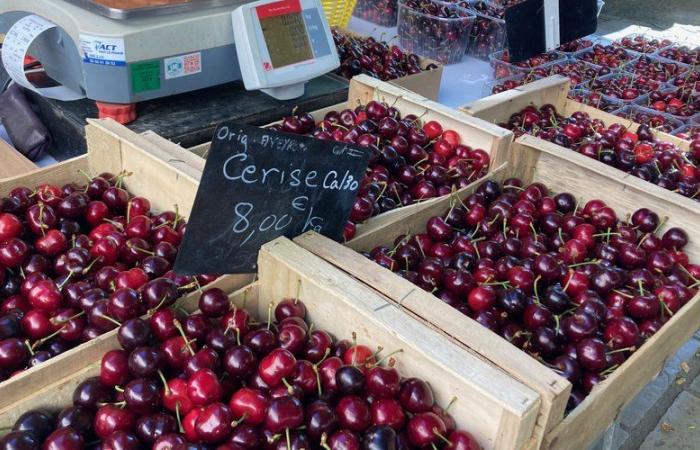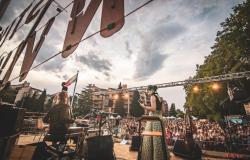Committed to reducing inputs, a group of arboriculturists from South Aveyron are working to ensure the survival of the red gold of the Tarn Valley.
Hurry slowly. While cherries are currently blooming on market stalls in France, the South Aveyron tree growing sector continues its transformation carried out as part of the Ecophyto program.
Regularly singled out – even locally with the Poppies movement – reduced to agricultural practices inherited from centuries of allegiance to chemistry, there are around twenty professional arborists who have voluntarily committed themselves to the system Dephy. An emanation of the Ecophyto plan, its roadmap aims to reduce the use of inputs on farms “while maintaining economic, social and environmental performance.”
The objective is clear. Drastically reduce the use of insecticides, herbicides and pesticides on farms partly focused on the production of cherries, the red gold of the valley doomed, without such initiatives, to certain disappearance.
Faced with the voracious appetite of the Asian fruit fly, the Drosophila Suzukii – capable of destroying the fruit of a year’s labour in a matter of hours – the cherry has seen its hegemony challenged by the mirabelle plum, which is less precocious but also less sensitive to the Asian peril.
Reduction in glyphosate consumption
Attached to their valley and to production which also ensures better profitability per hectare, “the Dephy group” has therefore decided to roll up its sleeves to restore the local emblem. To counter the famous fly, nets with proven effectiveness are now flourishing in the cherry orchards of the valley. Tests of spreading clay capable of deceiving the fly’s penchant for the color red are also being tested.
Experiments, protocols to follow, collection of results… In conjunction with the National Institute for Agricultural, Food and Environmental Research (INRAE) and the Interprofessional Technical Center for Fruit and Vegetables (CTIL), the group has made the valley a national reference for mid-mountain areas, ensuring continuity between laboratory research and field experimentation. With success?
“We are making progress. In 4 years, work on inter-row plant cover has already made it possible to reduce glyphosate consumption by 60%”, summarizes, for example, Nathalie Raitière, arboriculture project manager at Apaba. At the head of the small group, the engineer deliberately multiplies the experiments and is now banking on the generalization of nets for the 60 hectares of orchards in the “test group”.
Betting on a “spectacular decline” of the use of insecticides in a sector which stands out singularly from the rest of the department. The commune of Paulhe, as demonstrated by the “Adonis map of pesticide use in France”, is the one where the frequency of phytosanitary treatments is the highest.
“So we are moving forward step by step”
From there to completely excluding chemistry from farms as Loïc Almeras is already experimenting on his 4,000 m² plot? “It’s not on the agenda yet, at least for now, but it’s the direction.”comments the engineer who while still recognizing “some fears” among farmers hopes to be able to present organic cherries on the stalls “within 5 or 6 years.”
Between commercial and regulatory injunctions and the vagaries of the weather, many arborists and wine growers still want to reserve the possibility of conventional treatments for “generate a minimum income in the event of hard times”. All of us have stubborn habits, having been immersed in an agricultural world where every problem has a chemical solution.
“Reducing pesticides is fine. Everyone agrees, but we must also ensure the sustainability of farms. Be sure that trees planted 10 or 20 years ago will still be healthy in 5, on larger areas that multiply the risks for producers. We are not planting lettuce but orchards that take several years to reach production age. Many have no right to make mistakes. So we are moving forward step by step.”
A precaution shared by Benoit Paulhac, an arborist in Boyne and member of the Dephy group. After spending two years adapting the size of his cherry trees to the installation of nets, the thirty-year-old has just taken the plunge by equipping a little less than half of his cherry orchard.
“If it allows us to reduce the number of passes between the rows and the use of insecticide, we sign. But we prefer to remain cautious and be careful not to put our eggs in the same basket.” The very expression of peasant common sense which more than ever hesitates between tradition and modernity.
Irrigation et production intensive
Subsidised at a rate of 30 or 50%, the installation of nets – between €30,000 and €50,000/ha – remains very expensive for arboriculturists who are now tempted to make the most of their investment by intensifying production.
“Since everything costs more, the more you put underneath (the nets) the happier you are,” summarizes Nathalie Raitière who points out here the other problem in the valley: access to water.
“Between a non-irrigated plot and an irrigated plot, production can increase from roughly 5 or 6 tonnes per hectare to more than double. The size of the cherry also increases with price differences that can reach more than €1 per kilo.”
Far from being neutral for the profession which now pleads in favor of necessary water storage. A monopolization of resources? “Non, estimates the engineer. If we store at a given time when, like this year, water was flowing in abundance, we do not bother anyone. The water is then gradually returned to the environment. We therefore do not modify the natural cycle.”






